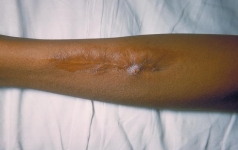Salmonella Fact Sheet
|
A salmonella lesion of the leg. Along with the advanced infection, the patient had sickle cell disease and osteochondrodystrophia. (Source: CDC) Salmonella is a large group of bacteria that infects humans and many animals. Approximately 2000 different sub-species, or serotypes, of Salmonella can sicken humans. The bacteria cause salmonellosis, an illness commonly associated with food poisoning. The flu-like typhoid fever, which only infects humans, is caused by the Typhi serotype. Delivery: Transmission of the Salmonella bacteria occurs through ingestion of contaminated food and drinks. A bioterrorist could simply drop samples of the bacteria onto food or drinks ready to be consumed. Outbreaks of Salmonella in the U.S. commonly occur because of improperly cooked food such as meat, poultry, seafood, and eggs and improperly prepared fruits, vegetables, milk, and other food and drinks. Foods and drinks can become contaminated when handled by an infected person who doesn’t wash their hands, through contact with bacteria-infested surfaces, or through the feces of infected individuals or animals. Production: Different Salmonella serotypes are found worldwide and in a variety of different environments. These locations include water, soil, insects, factory and kitchen surfaces, animal feces, and raw meats, poultry, and seafood. The bacteria can be isolated from these sources and grown. Approximately 40,000 salmonellosis cases with 600 deaths are reported yearly in the U.S. The number of actual cases may be 30 times higher, or more, since milder cases may not be reported or diagnosed. There are 400 cases of typhoid fever recorded in the U.S. yearly, but 75% of them are associated with international travel. Deaths are rare when medical attention is received, but occur in 12-30% of untreated cases. History: In 1984, the Rajneeshee religious cult contaminated the salad bars of 10 restaurants in Wasco County, Oregon, with Salmonella Typhimurium in a plot to lower voter turnout for a local election. The attack resulted in 751 cases of salmonellosis with no deaths. In New York City from 1900 to 1915, Mary Mallon, also known as Typhoid Mary, spread typhoid fever to 47 people, killing three, through food that she handled. |
Effects: Symptoms of salmonellosis begin 12 to 72 hours after infection and include nausea, diarrhea, fever, headaches, abdominal cramps, and vomiting. Salmonellosis usually lasts 4-7 days without treatment. A longer duration can lead to severe dehydration or the infection spreading into the bloodstream and other organs, which can cause death. When the infection is over, some people with salmonellosis develop Reiter's syndrome, characterized by joint pains, eye irritation, and painful urination that can last for months or years and lead to chronic arthritis. Different from salmonellosis, typhoid fever is characterized by fever, headache, constipation, weakness, chills, muscle ache, and a rash of flat, rose-colored spots in some cases. Untreated typhoid fever can last for 3-4 weeks and can cause death due to complications. Treatment: There are no vaccines for salmonellosis, but vaccines for typhoid fever are given to travelers going to countries where outbreaks are frequent. These vaccines, however, are not perfect and are more effective when questionable foods and drinks are avoided. Antibiotics, specifically ampicillin, gentamicin, ciprofloxacin, and a combination of trimethoprim and sulfamethoxazole, are given to patients with typhoid fever or severe salmonellosis. Some serotypes have developed some antibiotics resistance due to its use in feed animals. Administering intravenous fluids and electrolytes can remedy severe dehydration due to diarrhea. |
|||
(Sources: Centers for Disease Control and Prevention, Food and Drug Administration, Medline Plus) |
||||



